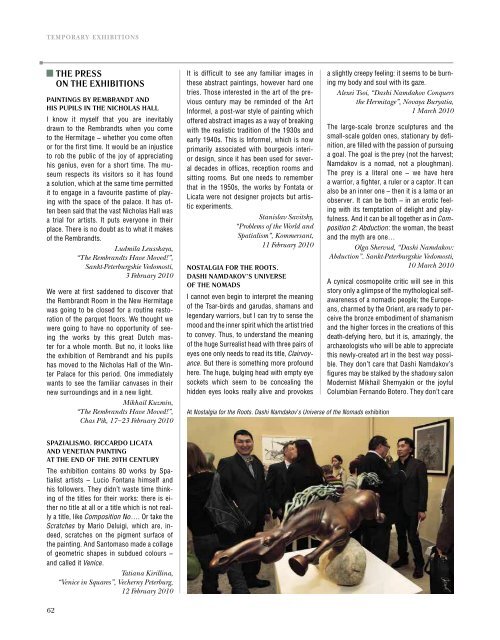The STaTe hermiTage muSeum annual reporT
The STaTe hermiTage muSeum annual reporT
The STaTe hermiTage muSeum annual reporT
Create successful ePaper yourself
Turn your PDF publications into a flip-book with our unique Google optimized e-Paper software.
temporary exhIbItIons<br />
J <strong>The</strong> preSS<br />
on <strong>The</strong> exhiBiTionS<br />
painTingS By remBrandT and<br />
hiS pupilS in <strong>The</strong> nicholaS hall<br />
I know it myself that you are inevitably<br />
drawn to the Rembrandts when you come<br />
to the Hermitage – whether you come often<br />
or for the first time. It would be an injustice<br />
to rob the public of the joy of appreciating<br />
his genius, even for a short time. <strong>The</strong> museum<br />
respects its visitors so it has found<br />
a solution, which at the same time permitted<br />
it to engage in a favourite pastime of playing<br />
with the space of the palace. It has often<br />
been said that the vast Nicholas Hall was<br />
a trial for artists. It puts everyone in their<br />
place. <strong>The</strong>re is no doubt as to what it makes<br />
of the Rembrandts.<br />
Ludmila Leusskaya,<br />
“<strong>The</strong> Rembrandts Have Moved!”,<br />
Sankt-Peterburgskie Vedomosti,<br />
3 February 2010<br />
We were at first saddened to discover that<br />
the Rembrandt Room in the New Hermitage<br />
was going to be closed for a routine restoration<br />
of the parquet floors. We thought we<br />
were going to have no opportunity of seeing<br />
the works by this great Dutch master<br />
for a whole month. But no, it looks like<br />
the exhibition of Rembrandt and his pupils<br />
has moved to the Nicholas Hall of the Winter<br />
Palace for this period. One immediately<br />
wants to see the familiar canvases in their<br />
new surroundings and in a new light.<br />
Mikhail Kuzmin,<br />
“<strong>The</strong> Rembrandts Have Moved!”,<br />
Chas Pik, 17–23 February 2010<br />
SpaZialiSmo. riccardo licaTa<br />
and veneTian painTing<br />
aT <strong>The</strong> end of <strong>The</strong> 20Th cenTury<br />
<strong>The</strong> exhibition contains 80 works by Spatialist<br />
artists – Lucio Fontana himself and<br />
his followers. <strong>The</strong>y didn’t waste time thinking<br />
of the titles for their works: there is either<br />
no title at all or a title which is not really<br />
a title, like Composition No…. Or take the<br />
Scratches by Mario Deluigi, which are, indeed,<br />
scratches on the pigment surface of<br />
the painting. And Santomaso made a collage<br />
of geometric shapes in subdued colours –<br />
and called it Venice.<br />
Tatiana Kirillina,<br />
“Venice in Squares”, Vecherny Peterburg,<br />
12 February 2010<br />
It is difficult to see any familiar images in<br />
these abstract paintings, however hard one<br />
tries. Those interested in the art of the previous<br />
century may be reminded of the Art<br />
Informel, a post-war style of painting which<br />
offered abstract images as a way of breaking<br />
with the realistic tradition of the 1930s and<br />
early 1940s. This is Informel, which is now<br />
primarily associated with bourgeois interior<br />
design, since it has been used for several<br />
decades in offices, reception rooms and<br />
sitting rooms. But one needs to remember<br />
that in the 1950s, the works by Fontata or<br />
Licata were not designer projects but artistic<br />
experiments.<br />
Stanislav Savitsky,<br />
“Problems of the World and<br />
Spatialism”, Kommersant,<br />
11 February 2010<br />
noSTalgia for <strong>The</strong> rooTS.<br />
daShi namdaKov’S univerSe<br />
of <strong>The</strong> nomadS<br />
I cannot even begin to interpret the meaning<br />
of the Tsar-birds and garudas, shamans and<br />
legendary warriors, but I can try to sense the<br />
mood and the inner spirit which the artist tried<br />
to convey. Thus, to understand the meaning<br />
of the huge Surrealist head with three pairs of<br />
eyes one only needs to read its title, Clairvoyance.<br />
But there is something more profound<br />
here. <strong>The</strong> huge, bulging head with empty eye<br />
sockets which seem to be concealing the<br />
hidden eyes looks really alive and provokes<br />
At Nostalgia for the Roots. Dashi Namdakov’s Universe of the Nomads exhibition<br />
a slightly creepy feeling: it seems to be burning<br />
my body and soul with its gaze.<br />
Alexei Tsoi, “Dashi Namdakov Conquers<br />
the Hermitage”, Novaya Buryatia,<br />
1 March 2010<br />
<strong>The</strong> large-scale bronze sculptures and the<br />
small-scale golden ones, stationary by definition,<br />
are filled with the passion of pursuing<br />
a goal. <strong>The</strong> goal is the prey (not the harvest;<br />
Namdakov is a nomad, not a ploughman).<br />
<strong>The</strong> prey is a literal one – we have here<br />
a warrior, a fighter, a ruler or a captor. It can<br />
also be an inner one – then it is a lama or an<br />
observer. It can be both – in an erotic feeling<br />
with its temptation of delight and playfulness.<br />
And it can be all together as in Composition<br />
2: Abduction: the woman, the beast<br />
and the myth are one…<br />
Olga Shervud, “Dashi Namdakov:<br />
Abduction”. Sankt-Peterburgskie Vedomosti,<br />
10 March 2010<br />
A cynical cosmopolite critic will see in this<br />
story only a glimpse of the mythological selfawareness<br />
of a nomadic people; the Europeans,<br />
charmed by the Orient, are ready to perceive<br />
the bronze embodiment of shamanism<br />
and the higher forces in the creations of this<br />
death-defying hero, but it is, amazingly, the<br />
archaeologists who will be able to appreciate<br />
this newly-created art in the best way possible.<br />
<strong>The</strong>y don’t care that Dashi Namdakov’s<br />
figures may be stalked by the shadowy salon<br />
Modernist Mikhail Shemyakin or the joyful<br />
Columbian Fernando Botero. <strong>The</strong>y don’t care<br />
that this sculpture is in no way “contemporary<br />
art”, as it never even attempts to speak<br />
its language. <strong>The</strong>y value the cultural experience<br />
of discourse in plastic form, which<br />
is all the more evident when these sculptures<br />
are viewed side by side with the monuments<br />
left behind by the ancient nomads.<br />
<strong>The</strong> Scythians, of course, have won this battle<br />
too – but we have the opportunity to see<br />
the transformation of the Ancient East in the<br />
age of Avatar.<br />
Kira Dolinina, “Avatar B.C.”,<br />
Kommersant, 2 March 2010<br />
waTercolour porTraiTS<br />
and decoraTive porcelain.<br />
new acQuiSiTionS<br />
At the end of 2009, the Hermitage made an<br />
awesome acquisition. It bought 92 watercolour<br />
portraits and over 140 Russian porcelain<br />
pieces from the Paris Gallerie Popoff (Popov<br />
Gallery). <strong>The</strong>se are unique objects, perfectly<br />
in line with the museum’s academic programme.<br />
According to Mikhail Piotrovsky,<br />
Director of the Hermitage, “this is a once-ina-century<br />
opportunity, we had to bend over<br />
backwards but get it”.<br />
Olga Luzina, “<strong>The</strong> Russia We Gained”,<br />
Fontanka.Ru, 19 April 2010<br />
For the first time, the visitors could see<br />
92 watercolours and over 140 porcelain<br />
pieces. <strong>The</strong> Hermitage bought these objects<br />
from Maurice Baruch, the current owner of<br />
the famous Parisian Gallerie Popoff. According<br />
to the experts, the unique watercolours<br />
and exquisite porcelain from the Popov collection<br />
reflect a high style of museum collecting.<br />
<strong>The</strong>y are of interest for professionals and<br />
amateurs alike, which is in like with the collecting<br />
policy of the Hermitage.<br />
Ludmila Leusskaya, “Returned Home<br />
Without an Auction”, Sankt-Peterburgskie<br />
Vedomosti, 22 April 2010<br />
“<strong>The</strong> wind in <strong>The</strong> pineS…”<br />
5,000 yearS of Korean arT<br />
<strong>The</strong>se unique and original works seem to<br />
have cheated time itself. Unscathed by hundreds<br />
of centuries, they have preserved their<br />
beauty to this day. Just like the old Korean<br />
song “<strong>The</strong> Wind in the Pines”, they have not<br />
been lost, swept away forever, and its pure<br />
sound can attune your perception for a special<br />
mode needed to appreciate the art unknown<br />
before…<br />
At Watercolour Portraits and Decorative Porcelain. New Acquisitions exhibition<br />
<strong>The</strong> imagination of those who created these<br />
masterpieces is original, and their execution<br />
is exquisite. Take a horseman which is not<br />
really a sculpture but rather a vessel or bell,<br />
topped with a dragon holding a pearl.<br />
Marina Yeliseyeva, “Twelve Treasures<br />
from the Land of the Morning Calm”,<br />
Sankt-Peterburgskie Vedomosti,<br />
3 June 2010<br />
This exhibition was long prepared and long<br />
awaited: in 1991 the Hermitage took its<br />
Scythian gold to the National Museum of Korea,<br />
and a return exhibition was first planned<br />
at that time. <strong>The</strong>se plans were remembered<br />
thanks to a purely political anniversary – it is<br />
twenty years since the establishment of diplomatic<br />
relations between Russia and South<br />
Korea. <strong>The</strong> exhibition was arranged by the<br />
Hermitage curators, who tried to achieve the<br />
temporary exhIbItIons<br />
most representative selection, to show all the<br />
most representative and outstanding pieces.<br />
<strong>The</strong> finds from royal tombs, Buddhist sculptures,<br />
ceramics and porcelain, portraits, applied<br />
art have filled the Nicholas Hall of the<br />
Winter Palace…<br />
Olga Luzina, “‘<strong>The</strong> Wind in the Pines’.<br />
5,000 Years of Freshness”, Fontanka.Ru,<br />
9 June 2010<br />
<strong>The</strong> poetic title is reminiscent of an old tune<br />
played on the plucked strings of a komungo.<br />
In the Korean tradition, the noise of the wind<br />
in the tops of the mighty pines is a symbol of<br />
all the pure, noble, and chaste. This spiritual<br />
mood is reflected by the exhibition itself.<br />
Yakov Yevglevsky, “<strong>The</strong> Wind in the Pines’,<br />
Parlamentskaya Gazeta,<br />
11 June 2010<br />
62 63




